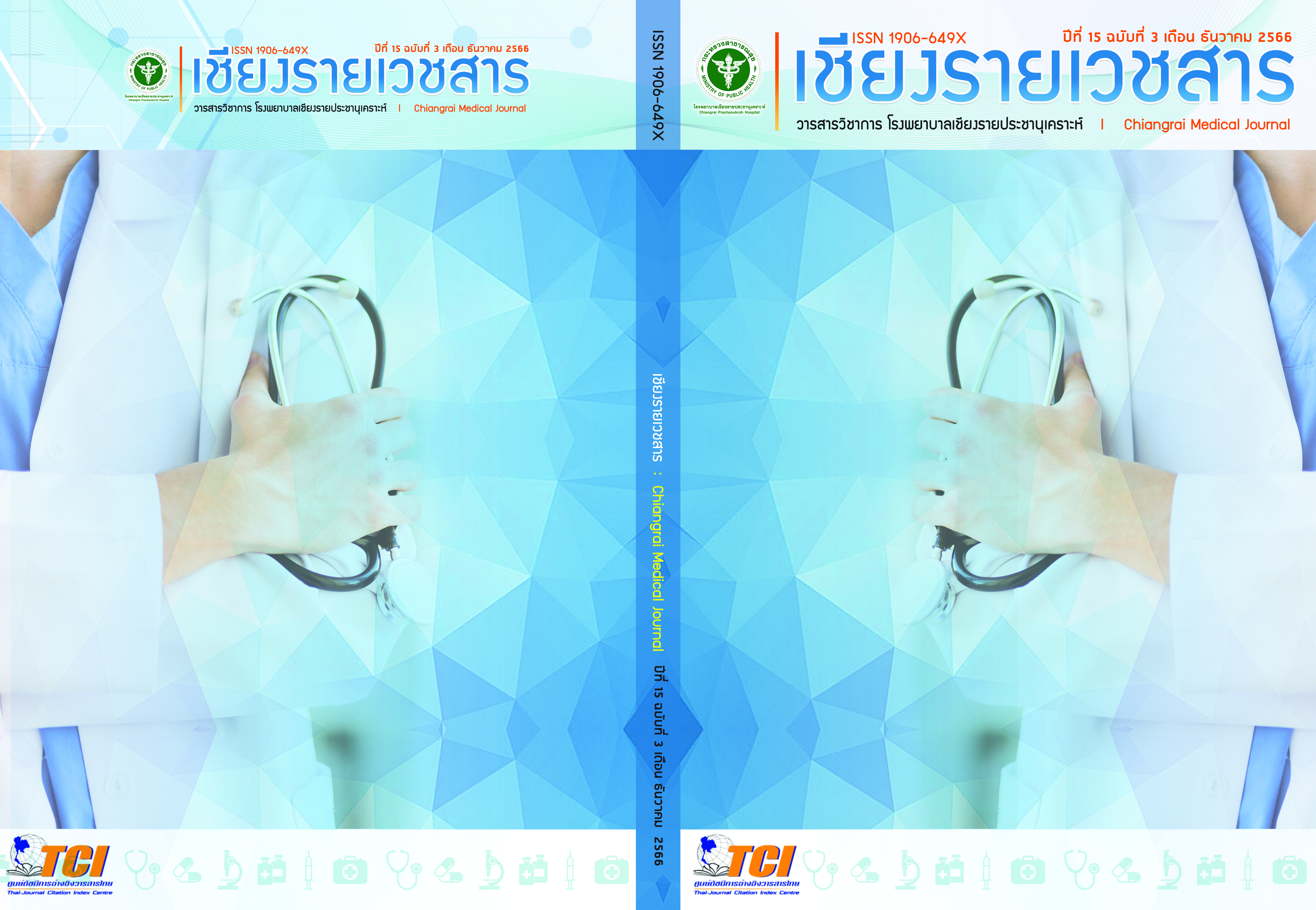ปัจจัยทางคลินิกที่ส่งผลต่อความสามารถในการช่วยเหลือตัวเองในระดับดี ของผู้ป่วยบาดเจ็บสมองระดับปานกลาง และระดับรุนแรง ในระยะ intermediate care ของจังหวัดเชียงราย
Main Article Content
บทคัดย่อ
ความเป็นมา ผู้ป่วยบาดเจ็บสมองระดับปานกลางและระดับรุนแรงมีโอกาสเกิดความพิการได้มาก จำเป็นต้องได้รับการฟื้นฟู ในระยะกลาง (intermediate care, IMC) ซึ่งต้องส่งต่อให้โรงพยาบาลชุมชนฟื้นฟูต่อเนื่องในช่วงเวลา 6 เดือน การทราบปัจจัยที่ส่งผลต่อความสามารถในการช่วยเหลือตัวเองได้ดี มีผลต่อการวางแผนฟื้นฟูและการคัดเลือกผู้ป่วยเพื่อส่งต่อให้โรงพยาบาลชุมชนในเครือข่ายมีประสิทธิภาพมากขึ้น
วัตถุประสงค์ เพื่อศึกษาปัจจัยทางคลินิกที่ส่งผลต่อความสามารถในการช่วยเหลือตัวเองในระดับดี ของผู้ป่วยบาดเจ็บสมองระดับปานกลาง และระดับรุนแรง ในระยะ IMC ของจังหวัดเชียงราย และเพื่อศึกษาผลลัพธ์ของการฟื้นฟูผู้ป่วยบาดเจ็บสมอง ระยะ IMC
วิธีการศึกษา เป็นการศึกษาแบบย้อนหลัง โดยทบทวนจากเวชระเบียนอิเล็คโทรนิกส์ ในช่วงเดือน ตุลาคม 2564-ธันวาคม 2566 แบ่งกลุ่มผู้ป่วยบาดเจ็บทางสมองระดับปานกลางและระดับรุนแรง ตามผลลัพธ์คือ ระดับความสามารถในการช่วยเหลือตัวเอง ด้วยแบบประเมินคะแนน Barthel Index (BI) ที่ 6 เดือน แบ่งเป็นกลุ่มผลลัพธ์ดี คือ BI > 15 คะแนน กลุ่มผลลัพธ์ไม่ดี คือ BI < 15 คะแนน เก็บข้อมูลพื้นฐานทั่วไป ข้อมูลการรักษาและผลลัพธ์ในระยะเวลา 6 เดือน นำข้อมูลมาวิเคราะห์ทางสถิติด้วย t-test, exact probability test, multivariable logistic regression analysis กำหนดค่านัยสำคัญทางสถิติที่ p-value <0.05
อย่างมีนัยสำคัญทางสถิติ ได้แก่ การที่ผู้ป่วยไม่เกิดภาวะปอดอักเสบแทรกซ้อนขณะรักษาตัวในโรงพยาบาล (Adjusted OR =4.84, 95%CI 1.35-17.35, p=0.015) ผล CT scan ไม่พบ hydrocephalus (Adjusted OR= 5.11, 95%CI 1.08-24.16, p=0.039) และ การที่ผู้ป่วยสามารถทำตามคำสั่งได้ก่อนจำหน่าย (Adjusted OR=3.90, 95%CI 1.10-13.82, p=0.035)
สรุปและข้อเสนอแนะ
การที่ผู้ป่วยไม่เกิดภาวะปอดอักเสบแทรกซ้อนขณะรักษาตัวในโรงพยาบาล ผล CT scan สมองไม่พบ hydrocephalus และการที่ผู้ป่วยสามารถทำตามคำสั่งได้ก่อนจำหน่าย เป็นปัจจัยที่ส่งผลต่อความสามารถในการช่วยเหลือตัวเองได้ดี สามารถนำมาใช้คัดเลือกกลุ่มผู้ป่วยบาดเจ็บสมองรุนแรงระดับปานกลางและรุนแรงที่สามารถส่งต่อเพื่อฟื้นฟูต่อเนื่องที่ รพ.ชุมชนได้ รวมทั้งควรเน้นการดูแลผู้ป่วยเพื่อป้องกันปอดอักเสบติดเชื้อขณะนอนโรงพยาบาล
Article Details

อนุญาตภายใต้เงื่อนไข Creative Commons Attribution-NonCommercial-NoDerivatives 4.0 International License.
เอกสารอ้างอิง
Mortality rate of patients with traumatic brain injury in Chiangrai. [internet] 2023[cited 2023 Sep 25]. Available from: https://cmi.ciorh1.com/web/index.php?r=service%2Findex&co_thip_new=DN0301&splevel=&chwcode=57&year=2022
Mar J, Arrospide A, Begiristain JM, Larrañaga I, Elosegui E, Oliva-Moreno J. et al. The impact of acquired brain damage in terms of epidemiology, economics and loss in quality of life. BMC Neurol. 2011;11:46.
Steyerberg EW, Mushkudiani N, Perel P, Butcher I, Lu J, McHugh GS, et al. Predicting outcome after traumatic brain injury: development and international validation of prognostic scores based on admission characteristics. PLoS Med. 2008;5(8):e165
Weber KT, Guimarães VA, Pontes Neto OM, Leite JP, Takayanagui OM, Santos-Pontelli TE. Predictors of quality of life after moderate to severe traumatic brain injury. Arq Neuropsiquiatr. 2016;74(5):409-15.
Islam MN, Thosingha O, Danaidustsadeekul S, Viwatwongkasem C. Factors explaining quality of life among people with moderate to severe traumatic brain injury in Bangladesh: a cross-sectional study. Pacific Rim Int J Nurs Res. 2022;26(1):146-60.
Sandhaug M, Andelic N, Vatne A, Seiler S, Mygland A. Functional level during sub-acute rehabilitation after traumatic brain injury: course and predictors of outcome. Brain Inj. 2010;24(5):740-7.
Lendraitienė E, Petruševičienė D, Savickas R, Žemaitienė I, Mingaila S. The impact of physical therapy in patients with severe traumatic brain injury during acute and post-acute rehabilitation according to coma duration. J Phys Ther Sci. 2016;28(7):2048-54.
Punjaisri S, Peunpratom N, Weerasan K. Clinical practice guideline of traumatic brain injury. Bangkok: Thanaplace; 2003.
KPI template of Service plan Intermediate Care (IMC) 2022. [internet] 2023 [cited Sep 25, 2023] available from: https://spd.moph.go.th/wp-content/uploads/2022/08/PDF-File_3.pdf
Dajpratham P, Meenaphant R, Junthon P, Pianmanakii S, Jantharakasamjit S, Yuwan A. The inter-rater reliability of Barthel Index (Thai version) in stroke patients. J Thai Rehabil 2006;16(1):1-9.
Intaratep N, Suksathien R. Clinical predictors of good functional outcome in patients with acute stroke. Formerly J Thai Rehabil Med. 2022;32(3):116-22.
Prathep S, Sriplung H, Phuenpathom N, Zunt J, Hirunpat S, Vavilala MS. Characteristics and outcomes of Thai patients hospitalized with severe traumatic brain injury between 2009 and 2011. J Med Assoc Thai. 2017;100 (8):843-9.
Iaccarino C, Carretta A, Nicolosi F, Morselli C. Epidemiology of severe traumatic brain injury.
J Neurosurg Sci. 2018;62(5):535-41.
Zygun DA, Zuege DJ, Boiteau PJ, Laupland KB, Henderson EA, Kortbeek JB, et al. Ventilator-associated pneumonia in severe traumatic brain injury. Neurocrit Care. 2006;5(2):108-14.
Kumar RG, Kesinger MR, Juengst SB, Brooks MM, Fabio A, Dams-O'Connor K, et al. Effects of hospital-acquired pneumonia on long-term recovery and hospital resource utilization following moderate to severe traumatic brain injury. J Trauma Acute Care Surg. 2020;88(4):491-500
Robba C, Rebora P, Banzato E, Wiegers EJA, Stocchetti N, Menon DK, et al. Incidence, risk factors, and effects on outcome of ventilator-associated pneumonia in patients with traumatic brain injury: analysis of a large, multicenter, prospective, observational longitudinal study. Chest. 2020;158(6):2292-303.
Shah AH, Komotar RJ. Pathophysiology of acute hydrocephalus after subarachnoid hemorrhage. World Neurosurg. 2013;80(3-4):304-6.
Dupont S, Rabinstein AA. Extent of acute hydrocephalus after subarachnoid hemorrhage as a risk factor for poor functional outcome. Neurol Res. 2013;35(2):107-10.
Maas AI, Hukkelhoven CW, Marshall LF, Steyerberg EW. Prediction of outcome in traumatic brain injury with computed tomographic characteristics: a comparison between the computed tomographic classification and combinations of computed tomographic predictors. Neurosurgery. 2005;57(6):1173-82.
Kowalski RG, Hammond FM, Weintraub AH, Nakase-Richardson R, Zafonte RD, Whyte J, et al. Recovery of consciousness and functional outcome in moderate and severe traumatic brain injury. JAMA Neurol. 2021;78(5):548-57.


